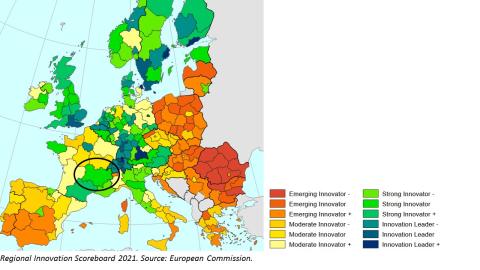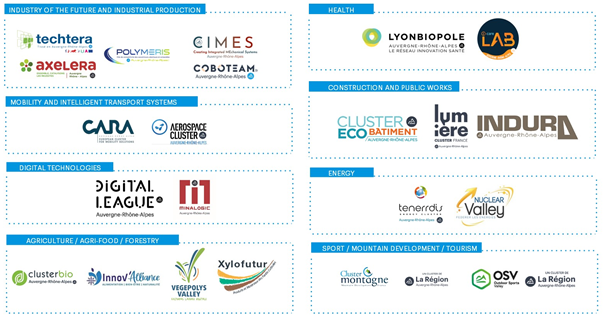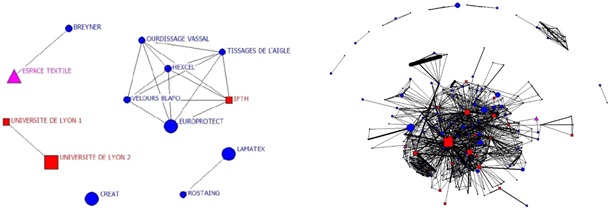Industrial Transition in Auvergne-Rhône-Alpes
Summary: The Lyon-based TECHTERA cluster has established itself as a key actor within the regional textile ecosystem. The “Pôle de compétitivité“ has become an integral part of the region’s economic development, internationalisation and R&I strategies and is a strategic partner for the Regional Council of Auvergne-Rhône-Alpes to facilitate regional industrial transition. Since its establishment in 2005, the cluster, in close collaboration with the region’s other innovation clusters, contributed to regional efforts to relocate industrial activities and helped strengthen industrial and technological sovereignty by initiating cross-sectoral R&I projects on areas such as Industry of the Future and Circular Economy. By stepping-up its participation in European projects, TECHTERA also contributed to the development of new value chains for its members.
The Auvergne-Rhône-Alpes Region
 HollyHarry/AdobeStock
HollyHarry/AdobeStock
Auvergne-Rhône-Alpes (AURA) is a region in southeast-central France and was created under the 2014 territorial reform of French regions through a merger of Auvergne and Rhône-Alpes. AURA has established itself as France’s second most important economic region (after the Parisian region) and Europe’s fourth most important region in terms of GDP. It is home to some eight million people, and is the location of more than 800,000 business units, eight universities, more than 600 public and private laboratories and eight major research infrastructures (“Très Grandes Infrastructures de Recherche” (TGIR)). Auvergne-Rhône-Alpes has a strong and diversified manufacturing base, distinguished by both high-tech industries and well-established traditional sectors that are adjusting to change to remain competitive, with support from the Regional Council. According to the EU’s Regional Innovation Scoreboard 2021, AURA is a Strong Innovator.
Through its „Regional Plan for the Economy, Training, Research and Innovation 2022-2028“, the Auvergne-Rhône-Alpes region sets out its ambitions in terms of the economy, tourism, higher education, research and innovation, training and vocational guidance for the next six years in five strategic directions, ranging from re-industrialisation to digital and green transition and skills development. The plan complements three core regional strategies on Economic Development and Internationalisation (SRDEII), Research and Innovation (SRESRI) and (upcoming) Vocational Training (CPRDFOP).

INDUSTRIAL ECOSYSTEMS
In order to cope with a globalised economy and the significant competition between territorial ecosystems that it generates, the Auvergne-Rhône-Alpes region concentrates its resources on “key sectors”, which can be grouped into eight industrial ecosystems as defined in the European Commission’s New Industrial Strategy. They all encompass players from the smallest start-ups to the largest companies, from academia to research, service providers to suppliers:
- Healthcare Industries
- Smart Factory (Chemistry, Materials, Textiles),
- Transport, Mobility, Logistics
- Digital (Microelectronics, AI, Robotics)
- Energy (Hydro-Electricity, Agricultural Production)
- Construction
- Forest-Based Products
- Tourism
Out of the region’s key sectors, four sectors of excellence have been identified, which are to position the region as a leader: healthcare industry, sustainable materials, microelectronics and artificial intelligence as well as hydrogen.
STRATEGIC CHALLENGES
Strategic challenges, which have been identified and addressed in the region’s economic plan as well as the 2014-2020 smart specialisation strategies of both Auvergne and Rhône-Alpes are:
1. digital transformation,
2. a high demand for skilled workers,
3. a trend towards de-industrialisation,
4. sustainable tourism,
5. carbon neutrality, and
6. changing patterns in the mobility supply chain.
CLUSTER POLICY and CLUSTERS

The Auvergne-Rhône-Alpes region relies on clusters as preferential partners for the vitalisation of the region’s key sectors. Innovation Clusters (“Pôles de compétitivité“) and Regional Partner Clusters (with a particular focus on SME support) are at the heart of the region’s economic development and innovation strategies (SRDEII and SRESRI). They are considered essential tools to facilitate collaboration between companies and research and support their development, innovation and internationalisation projects. As part of the 2017-2021 Economic Development Strategy (SRDEII), the region was keen to reduce the number of clusters from 32 to 22 by merging existing clusters and by encouraging pooling and resources both between clusters and with the regional development agency. Today, there are 12 innovation-driven Innovation Clusters (“Pôles de compétitivité de la région“) and 10 Regional Partner Clusters at the heart of the region’s sector policy (see above illustration).
Following a decision by the federal government in 2019 to regionalise the innovation cluster policy, the 13 regions in France became the main contact for the “Pôles de Compétitivité” while the federal government remains the guarantor of the quality label and continues to rely, in conjunction with the regions, on innovation clusters as part of national innovation and industrial sector policies.
In the AURA region, the Regional Council of Auvergne-Rhône-Alpes is the body responsible for cluster policy and, like in every other region in France, the managing authority for the European Regional Development Fund (ERDF) and European Social Fund (ESF). In addition to providing financial support to all 22 regional clusters, Regional Council representatives with voting powers sit on the administrative councils of all clusters and are thus directly involved in their strategic decision making. Moreover, the Regional Council provides technical support to all clusters by letting clusters use its spacious headquarter in Lyon for free, supporting communication activities and facilitating internationalisation activities on the basis of bilateral Joint Conventions. In addition, the Council facilitates cross-cluster-collaboration among all regional clusters, such as by launching a collective of its regional “Pôles de compétitivité” on Industry 4.0 cross-fertilisation in 2018.
In return, the region’s 22 clusters provide valuable input, in particular for the development of regional strategies, including efforts by the region to relocate the production of goods and to strengthen industrial and technological sovereignty, or the drafting of innovation calls, such as a recent call for hydrogen production and uses. Moreover, input from the clusters was essential for the successful application for the two new regional “European Digital Innovation Hubs” (EDIHs) MINASMART and POLYTRONCIS.
THE TEXTILE ECOSYSTEM
The French textiles market is a highly-developed, mature market with many domestic and international players. In 2020, the French textile industry was comprised of approximately 2,100 companies with a total workforce of 61,910 employees. Apparel accounted for a turnover of €13.3 billion in 2020 and exports worth €9.4 billion.
The industry in France, although large, is dominated by several small, niche companies (63%) selling a small quantity of highly technical and high value products. The activities of these companies cover the many stages of textile manufacturing: spinning, downtwisting, weaving, knitting, finishing, tailoring/assembly. The French functional and technical textile industry operates in many industries, mainly in the fields of industrial textiles, healthcare, protection, security and defence, construction and infrastructure, agriculture, sports and leisure.
The Auvergne-Rhône-Alpes region accounts for 28% of the country’s total textile sector, with almost 600 companies active in the textile industry, employing more than 17,000 workers and generating a turnover of €3.5 billion in 2020.
Like all processing industries, the textile industry is facing significant process and environmental challenges, such as digital transformation, reduction in energy consumption, reduction of pollution, especially linked to certain stages of the process (for example, dyes or surface coatings), and reduction of material consumption.
Further reading:
Union des Industries Textiles, Rapport D’Activité 2020-2021, https://www.techtera.org/wp-content/uploads/2021/07/rapport-annuel-uit-2021.pdf (in French)
TECHTERA
 josefkubes/AdobeStock
josefkubes/AdobeStock
The Lyon-based “Pôle de Compétitivité” TECHTERA was founded in 2005 and considers itself a “leader of the textile ecosystem”, able and encouraged to interact with textile companies and stakeholders located all across France. This approach is explicitly mentioned in the cluster’s strategic documents, in particular the “Contrat de Performance” with the National Government. The contract, which is revised in detail on a regular basis, defines the cluster’s objectives for the next years. While the critical mass of committed members is based in the region, the cluster has reciprocal agreements with organisations in different parts of France, namely in eastern France (Alsace Textile Cluster), Hauts-de France (CCI Hauts-de-France) and southern France (IUT Sud), which act as sort of “satellite” clusters. Funding of the cluster rests on a solid mix of public subsidies (39%), private services (22%), membership fees (21%), contributions from trade unions and board members (15%), and (increasingly) EU project funding (3%).
MAIN FEATURES
TECHTERA counts 258 committed participants (as of 2021) from all relevant categories (industry, research & education, intermediates, marketing & communication, government & public administration). 214 participants belong to industry (199 small and medium-sized enterprises and 15 large players). Other committed participants are: 31 R&D institutions, universities and technical centres, 6 associations and 5 clusters. Because of the close institutional linkages with the Regional Council, the cluster’s work is based on a solid (and fruitful) Triple Helix structure (university-industry-government relationships).
The cluster management team consists of fifteen well-qualified staff members. Work of the cluster management is based on a comprehensive cluster strategy (“Cluster Roadmap 2019-2022”) with the clear mission to “strengthen the competitiveness of its members through collaborative innovation” and “contributing to the influence of the French textile industry beyond its borders.” At the heart of the strategy are three technological targets: i) intelligent and high-performance materials, ii) circular economy and resource economy, and iii) industry of the future and new economic models. A revised strategy is to be published in early 2023.
Since 2005, TECHTERA has ranked among the country’s renowned “Pôle de Compétitivité” and carries the GOLD Label of the European Cluster Excellence Initiative since 2016. The cluster is a founding member of the European Economic Interest Group EU-TEXTILE2030 EEIG and a member of the European Technology Platform for the Future of Textiles and Clothing (Textile ETP).
SERVICE PORTFOLIO
Digital and green industrial transition and building up resilience are equally important objectives of the cluster initiative. In order to achieve these goals, the cluster management narrowed down its service portfolio to three targeted support activities:
1. Stimulating and accelerating Research and Innovation;
2. Facilitating Business Development; and
3. Providing an Industrial Accelerator Platform.
Particular focus lies on the promotion of European collaboration projects, which can be facilitated through TECHTERA’s additional role as designated National Contact Point (PCN) for the EU`s framework programme HorizonEurope on behalf of the French Ministry of Economics.
ACTIVITES TOWARDS INDUSTRIAL TRANSITION
At the heart of its activities towards industrial transition are the cluster’s so-called “Clubs”, which are groups of cluster members joining forces to embrace the opportunities coming from new technologies. TECHTERA organises three Clubs, one on Smart Textiles (Club STeW), on Circular Economy (Club RECIT), and on Industry of the Future (formerly Club ICI4.0).
Over the last three years, TECHTERA and the members of the RECIT club have put in place a collective dynamic to move the textile sector towards a greener production in all textile issues, i.e. recycling, eco-efficient processes, short circuits and sustainable procurement. The club's quarterly meetings have given rise to collective actions, such as the initiation of collaborative research projects, in particular two HorizonEurope projects on new value chains and recycling (MC4 and CALIMERO), mutual company visits or the organisation of large-scale B2B events and hackathons. In addition, TECHTERA is a partner of the “European Cluster Partnership for Going International” REC-N-COMP, aimed at supporting the internationalisation of European SMEs whose activities relate to the manufacture of composites based on recycled materials, including textiles.
The Club Industry of the Future encouraged its members to define the specificities of Industry of the Future applied to textiles. For example, cluster members elaborated several projects related to Enterprise Resource Planning (ERP) as a digital transformation tool. In order to provide further support to SMEs in their digital transformation efforts, TECHTERA got directly involved in the establishment of two European Digital Innovation Hubs (EDIH) in the Auvergne-Rhône-Alpes region. Moreover, TECHTERA is an active contributor to the EUSALP Macroregional Strategy for the Alpine area and obtained an Alpine Space Interreg project as well as the EU-TEXTILE2030 COSME project, which led to the creation of the European Economic Interest Group EU-TEXTILE2030 EEIG.
With the overall aim of building up social and economic resilience in the region and addressing disruptions in supply and value chains, TECHTERA strongly increased its European outreach in EU projects and partnership over the past years. In addition to its participation in a European Cluster Partnership and its Interreg-related activities, the cluster is Partner/Coordinator of two COSME and two HorizonEurope projects, such as the EU-ALLIANCE, which aims to support the internationalisation of SMEs in the fields of technical textiles, connectivity, cutting-edge technologies and advanced materials, in order to reach dual-use markets Defence/Security in several targeted countries. In 2021, TECHTERA was involved in a total of 13 European project proposals.
IMPACT

Regional textile network in 2005 (Source: epures) Regional textile network in 2010 (Source: epures)
Over the past 17 years, TECHTERA has established itself as a key actor within the regional and national industrial ecosystem and facilitated digital and green transition as well as the building-up of resilience. An earlier study by the French urban planning agency epures visualised the significant increase of collaboration among research centres (in red), companies (blue) and associations (purple) from the Rhône-Alpes textile ecosystem since the establishment of Techtera as a “Pôle de compétitivité” in 2005.
Over time, TECHTERA managed to increase its membership base by an annual average of 17% and with that its total revenues. This success is strongly driven by the cluster’s successful outreach activities, particularly on social media. The total number of LinkedIn subscribers has increased by 35.5% from 2020 to 2021 and the total number of Twitter subscribers by 9%. Some 70% of all members report a high level of satisfaction with the cluster’s services and activities.
Another indicator for the cluster’s successful work is the total number of R&D projects. Since 2005, TECHTERA has successfully participated in 243 textile-related Research and Innovation projects with a total funding level of €618.8 million. The cluster’s knowledge and expertise fed into regional efforts to relocate industrial activities and helped strengthening industrial and technological sovereignty.
Moreover, TECHTERA’s increased participation in EU initiatives have led to a measurable expansion of its European network and closer ties to EU stakeholders, a better understanding of topics, trends, policies and market opportunities in the EU and a better integration of the cluster’s member companies in European textile value chains.
Lessons Learned and Transferability

The TECHTERA cluster has established itself as a key actor within the regional textile ecosystem. The Lyon-based “Pôle de compétitivité“ is an integral part of the region’s economic development, internationalisation and R&I strategies and has become a strategic partner for the Regional Council of Auvergne-Rhône-Alpes to facilitate regional industrial transition. Since its establishment in 2005, the cluster, in close collaboration with the region’s other innovation clusters, contributed to regional efforts to relocate industrial activities and helped strengthen industrial and technological sovereignty by initiating numerous cross-sectoral R&I projects on areas such as Industry of the Future and Circular Economy. By stepping-up its participation in European projects, TECHTERA also contributed to the development of new value chains for its members.
RECOMMENDATIONS
The case of TECHTERA and the Auvergne-Rhône-Alpes region highlights the important role of policy support for cluster-based economic development at national and regional levels. Moreover, it shows the need for both, an effective interplay of regional economic and innovation strategies and a clear commitment to clusters as agents of change. The case also demonstrates how cluster organisations can address digital and green transition by developing a targeted service portfolio and by including members in the development of solutions. Finally, the case underlines the relevance of international engagement and partnering in European programmes and initiatives in order to access new value chains, technologies and skills.